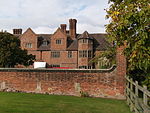Boscobel House
Country houses in ShropshireEnglish Heritage sites in ShropshireGrade II* listed buildings in ShropshireHistoric house museums in ShropshireTimber framed buildings in England ... and 1 more
Use British English from August 2011

Boscobel House (grid reference SJ837082) is a Grade II* listed building in the parish of Boscobel in Shropshire. It has been, at various times, a farmhouse, a hunting lodge, and a holiday home; but it is most famous for its role in the escape of Charles II after the Battle of Worcester in 1651. Today it is managed by English Heritage.
Excerpt from the Wikipedia article Boscobel House (License: CC BY-SA 3.0, Authors, Images).Boscobel House
Wood Road, South Staffordshire Brewood and Coven
Geographical coordinates (GPS) Address Website External links Nearby Places Show on map
Geographical coordinates (GPS)
| Latitude | Longitude |
|---|---|
| N 52.6716 ° | E -2.2416 ° |
Address
Boscobel House
Wood Road
WV8 1QT South Staffordshire, Brewood and Coven
England, United Kingdom
Open on Google Maps









